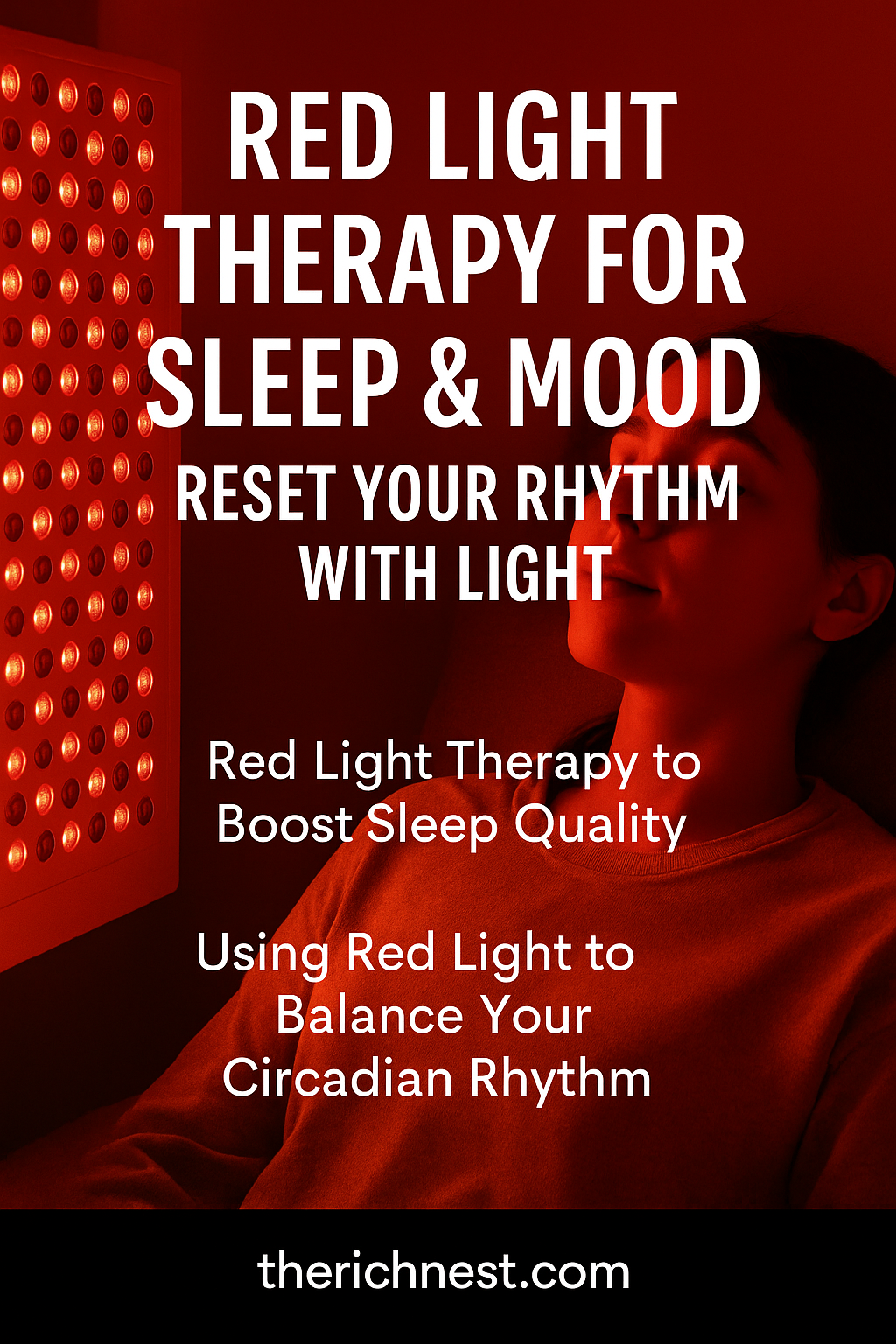Red Light Therapy for Sleep & Mood: Reset Your Rhythm with Light
Introduction: Can Light Really Help You Sleep Better?
We spend so much time trying to wind down—meditation apps, blackout curtains, magnesium, CBD... But what if the solution to better sleep and improved mood was as simple as flipping on the right kind of light?
Red light therapy is gaining traction as a science-backed, drug-free way to improve sleep quality, reduce anxiety, and rebalance your body’s natural rhythm.
This form of light therapy is different from the glaring blue light emitted by phones and computers. Red light works in harmony with your body’s biological processes. As more people look for non-pharmaceutical ways to sleep better, red light is becoming a favored evening ritual.
In this post, we’ll explore how red light therapy supports sleep and mood, how it impacts your circadian rhythm, and the best ways to incorporate it into your routine.
The Link Between Light and Your Circadian Rhythm
Your circadian rhythm is your body’s internal clock. It tells you when to feel awake, alert, tired, and ready for sleep. It’s regulated largely by light exposure, especially in the morning and evening.
Bright blue light—like what comes from phones, laptops, and overhead LEDs—disrupts this rhythm by blocking melatonin, the hormone that signals your body it’s time to rest. Red light, however, does the opposite.
How Red Light Supports Circadian Balance:
-
Stimulates melatonin production without suppressing it like blue light does
-
Triggers parasympathetic activation, calming your nervous system
-
Supports natural cortisol decline in the evening
-
Gently cues your body that it's time to rest
Physiologically, red light penetrates the skin and indirectly signals the suprachiasmatic nucleus (SCN)—the brain's master clock—to slow cortisol release and shift toward rest. This signaling cascade reinforces consistent sleep-wake cycles.
Unlike harsh overhead lighting, red light promotes a smoother transition into sleep—without the jitters or side effects of melatonin supplements.
Red Light Therapy to Boost Sleep Quality
Red light therapy doesn’t knock you out like a sedative. Instead, it helps your body naturally shift into sleep mode. Over time, this promotes deeper, more restorative rest.
Benefits:
-
Helps you fall asleep faster by signaling the pineal gland to increase melatonin
-
Lengthens deep sleep and REM cycles, essential for healing and memory consolidation
-
Improves next-day alertness and mood by regulating serotonin and cortisol
-
Reduces nighttime anxiety and overthinking that can keep you awake
Real Research:
A 2012 clinical trial on female basketball players found that 30 minutes of red light therapy daily for two weeks improved sleep quality and melatonin levels. Participants also reported better morning focus and reduced fatigue.
A 2021 review published in Frontiers in Neuroscience suggests that red and near-infrared light exposure at night may positively modulate the pineal gland and sleep-related brainwave patterns.
These studies point to red light’s potential to rebalance circadian timing while reducing cortisol and promoting brainwave states associated with deeper sleep.
Using Red Light to Balance Your Circadian Rhythm
Your body thrives on rhythm. And light is the most powerful tool for tuning your internal clock. Red light therapy helps re-establish that rhythm if it’s been thrown off by stress, travel, night shifts, or screen time.
Timing Tips:
-
Evening (1–2 hrs before bed): Use a red light panel, lamp, or mask for 10–20 minutes. This primes your brain for melatonin production.
-
Nighttime routine: Replace overhead or bedside bulbs with red LED bulbs to create a low-light environment.
-
Morning wakeup: Avoid red light exposure. Seek natural or white light instead to stimulate cortisol and help you wake up.
-
Traveling or shift work: Use red light therapy consistently to help anchor your new sleep-wake schedule. This is especially helpful during jet lag or schedule transitions.
Bonus Tip:
Create a circadian-friendly bedroom by combining red light with blackout curtains, sound dampening, and a consistent bedtime.
Red Light Therapy for Mood Regulation
Sleep and mood are intimately connected. When you sleep better, you feel better. But red light also affects mood directly, making it a powerful wellness tool beyond sleep.
Mental Health Benefits:
-
Improves serotonin activity: Red light helps regulate this feel-good neurotransmitter, which also plays a role in sleep.
-
Reduces symptoms of anxiety and depression: Especially in individuals with circadian rhythm disruptions or SAD.
-
Supports brain plasticity and mental clarity: Red and infrared light are believed to support neurogenesis (the creation of new neurons).
-
Soothes stress-related inflammation: Chronic stress can increase inflammation markers; red light helps calm them down.
Clinical evidence shows that red light may alleviate depression symptoms, especially in individuals with seasonal affective disorder (SAD). It may also play a role in reducing limbic system hyperactivity—an underlying factor in chronic anxiety.
Best Red Light Devices for Sleep and Mood
When choosing a red light device for relaxation and circadian health, prioritize comfort, convenience, and the right wavelengths. Not all red light devices are created equal.
What to Look For:
-
Wavelengths between 630–660nm (red) and 850nm (infrared)
-
Low to moderate irradiance for nighttime use to avoid overstimulation
-
Hands-free or ambient-friendly formats like lamps or panels
Top Picks from The Rich Nest:
-
ApolloGLOW – The Pinnacle of Luxury Red Light Skincare & Sleep Rituals
-
Stylish and spa-like; great for nightstand or skincare+sleep multitasking
-
Provides gentle facial illumination that relaxes the nervous system while rejuvenating the skin
-
-
ApolloARC – Clinical-Grade Full Body Relaxation
-
Full-body coverage and gentle heat; ideal for winding down before bed
-
Can be used in reclining positions to support parasympathetic dominance
-
These devices are designed to make red light therapy an enjoyable and effective part of your wind-down routine.
Sample Evening Routine with Red Light
A calming wind-down routine anchored by red light therapy helps your body and brain shift into sleep mode gradually, not abruptly.
| Time | Activity | Red Light Use |
|---|---|---|
| 7:00 PM | Light dinner | Begin dimming overhead lights |
| 8:00 PM | Stretching or meditation | Use ApolloARC or red panel for 15 minutes |
| 8:30 PM | Skincare routine | Apply with ApolloGLOW mask for 10 mins |
| 9:00 PM | Reading or journaling | Keep room lit only with red LED lamp |
| 9:30 PM | Lights off, sleep prep | Optional: 5-minute session near sleep mask |
Doing this consistently reinforces your body’s signal to rest and regenerate.
Final Thoughts: Should You Use Red Light for Sleep?
If you’ve struggled with falling asleep, feeling rested, or maintaining a calm mood throughout the day, red light therapy is a natural, low-risk solution worth exploring.
It works with your body—not against it—to support your hormones, brain, and circadian rhythm. Unlike supplements or sleep medications, it builds long-term resilience without dependency.
Ready to transform your evenings? Shop the best red light devices at TheRichNest.com
Wind down. Glow up. Sleep better—naturally.


